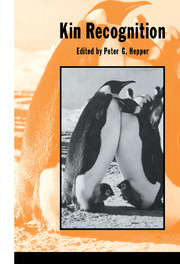Book contents
- Frontmatter
- Contents
- List of contributors
- Preface
- Introduction
- 1 The correlation between kinship and behaviour in non-human primates
- 2 Co-operation and reciprocity in birds and mammals
- 3 Kinship and fellowship in ants and social wasps
- 4 Successes and failures of parent–offspring recognition in animals
- 5 Kinship, kin discrimination and mate choice
- 6 Genetic components of kin recognition in mammals
- 7 Kin recognition in amphibians
- 8 Kin recognition cues of vertebrates
- 9 Recognizing kin: ontogeny and classification
- 10 Parental states as mechanisms for kinship recognition and deception about relatedness
- 11 Fetal learning: implications for the development of kin recognition
- 12 Information processing and storage during filial imprinting
- 13 The honey bee as a model kin recognition system
- 14 Mutual mother–infant recognition in humans
- Author index
- Species and common name index
- Subject index
5 - Kinship, kin discrimination and mate choice
Published online by Cambridge University Press: 06 January 2010
- Frontmatter
- Contents
- List of contributors
- Preface
- Introduction
- 1 The correlation between kinship and behaviour in non-human primates
- 2 Co-operation and reciprocity in birds and mammals
- 3 Kinship and fellowship in ants and social wasps
- 4 Successes and failures of parent–offspring recognition in animals
- 5 Kinship, kin discrimination and mate choice
- 6 Genetic components of kin recognition in mammals
- 7 Kin recognition in amphibians
- 8 Kin recognition cues of vertebrates
- 9 Recognizing kin: ontogeny and classification
- 10 Parental states as mechanisms for kinship recognition and deception about relatedness
- 11 Fetal learning: implications for the development of kin recognition
- 12 Information processing and storage during filial imprinting
- 13 The honey bee as a model kin recognition system
- 14 Mutual mother–infant recognition in humans
- Author index
- Species and common name index
- Subject index
Summary
Non-random mating can be an important cause of evolutionary change within populations (see, e.g. Partridge, 1983). While several factors can lead to non-randomness in mating – dispersal patterns, intrasexual competition, mating preferences, etc. – it is the possible role of mate choice in differential mating success that has excited the greatest interest among evolutionary biologists. In part this is because, while mate choice is at the heart of part of Darwin's (1859, 1871) original theory of sexual selection, attempts to model the evolution of mating preferences have proved contentious and tests of models often equivocal (Read, 1990; Bateson, 1983; Bradbury & Andersson, 1987). Nevertheless, there is no shortage of suggestions as to the criteria on which mating preferences might be based (e.g. Halliday, 1978; Hamilton & Zuk, 1982; Bateson, 1983) and, in some cases, convincing empirical support has been forthcoming (e.g. Semler, 1971; Andersson, 1982; Majerus, 1986).
A number of lines of argument point to the degree of relatedness between potential mates as a criterion in mate choice (Bateson, 1983, 1988; Smith, 1979; Shields, 1982, 1983; Partridge, 1983). The degree to which individuals of sexually reproducing species outbreed and therefore mate with others of differing genotype is likely to have important consequences for their reproductive success, mainly through the effects of dispersal costs, changes in the level of homozygosity and indirect fitness (e.g. Smith, 1979; Bateson, 1983; Partridge, 1983). It seems likely that extremes of inbreeding or outbreeding will incur both advantages and disadvantages for individual reproductive success and that an optimal balance between them might be expected under selection.
- Type
- Chapter
- Information
- Kin Recognition , pp. 125 - 147Publisher: Cambridge University PressPrint publication year: 1991
- 10
- Cited by



